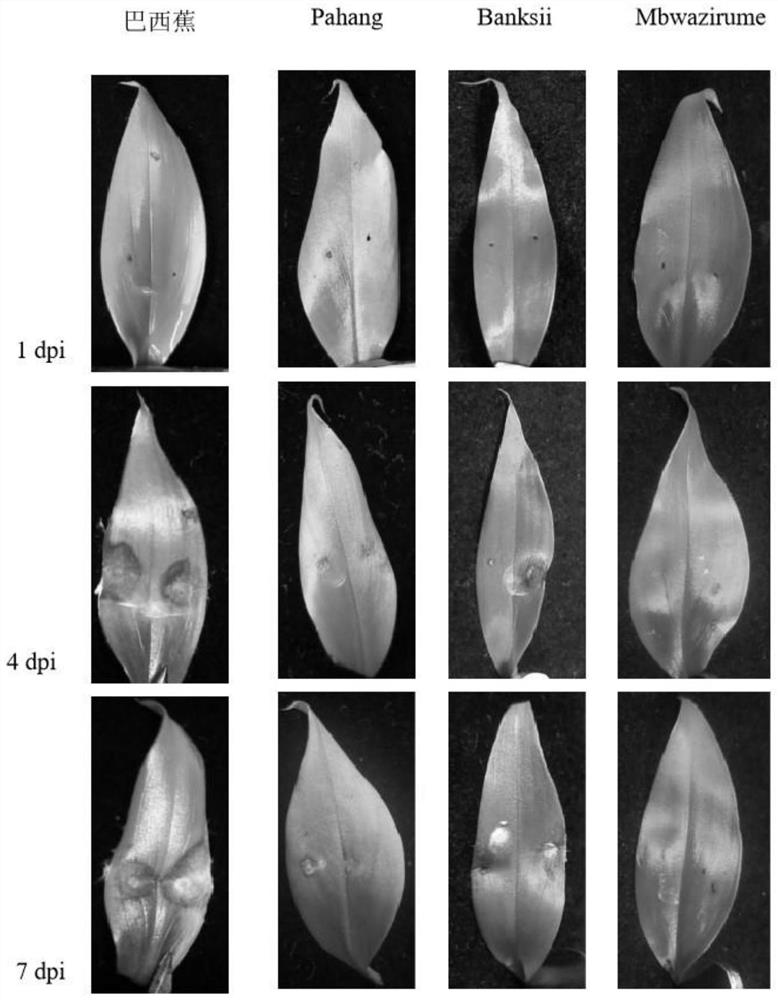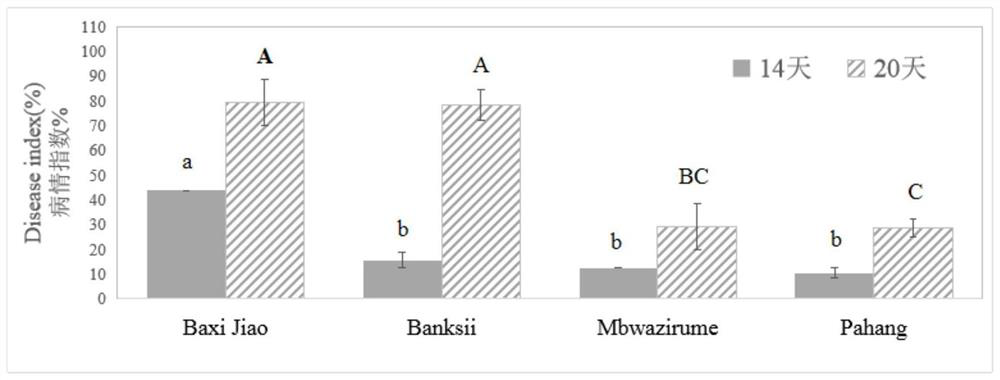Method for identifying tropical resistance of different banana varieties to No. 4 physiological race of fusarium wilt by using tissue culture seedlings
A technology of physiological races and tissue culture seedlings, which is applied in biochemical equipment and methods, biological material analysis, microbial measurement/inspection, etc., and can solve problems such as large footprint, cross-infection of growth conditions, and influence of resistance identification
- Summary
- Abstract
- Description
- Claims
- Application Information
AI Technical Summary
Problems solved by technology
Method used
Image
Examples
Embodiment 1
[0047] Example 1. A method of utilizing tissue culture seedlings to identify the resistance of different banana varieties to No. 4 physiological race tropical type of fusarium wilt
[0048] 1.1 Cultivation of rooted seedlings of different banana varieties
[0049] The tissue-cultured seedlings of different banana varieties were multiplied and cultivated to obtain clustered shoots with relatively consistent growth; the clustered shoots were cut into individual plants and transferred to the rooting medium, and each bottle of medium was transferred to 5 plants, a total of 40 bottles, 200 strain.
[0050] Culture conditions: the temperature of the culture room is 25-28°C, the photoperiod is 12h light and 12h dark, and the light intensity is 1600-2000Lux.
[0051] 1.2 Inoculation method of pathogenic bacteria in banana tissue culture seedlings
[0052] Preparation of banana fusarium wilt spore suspension: Activate the TR4 strain stored at -20°C on a PDA solid medium, culture at a...
Embodiment 2
[0069] Embodiment 2 utilizes tissue culture plantlet to identify the method for TR4 resistance of different banana varieties in greenhouse
[0070] Banana germplasm resources to be tested: Banana germplasm resources introduced from the International Biodiversity Research Center and preserved in the Yunnan Academy of Agricultural Sciences. Using the above-mentioned identification results of the same banana germplasm resources in the greenhouse for disease resistance, the inoculated strains were the same strain.
[0071] 2.1 Banana seedling cultivation
[0072] The above-mentioned banana germplasm resources were selected for tissue culture before inoculation. The seedlings were cultured in the matrix coconut peat in the greenhouse for about 6 weeks. After growing to 10cm, they were used for artificial inoculation of TR4. Each germplasm was inoculated with more than 20 plants per batch. July and July 2019 In August 2019, 2 batches were inoculated.
[0073] 2.2 Culture of TR4 sp...
Embodiment 3
[0086] Example 3 Inoculation of rooted tissue cultured seedlings wounded roots in tissue culture bottle with TR4 strain
[0087] Steps: (1) After the rooted seedlings are cultivated for 15-20 days, add 300 μL of 1×10 6 The number of spores / mL bacterial liquid is tested in a sterile workbench; (2) Reclose the tissue culture bottle that has been inserted into the strain, and place it at a temperature of 25-28°C, photoperiod: 12h light and 12h dark, and the light intensity is 1600-2000Lux tissue culture indoor culture observation, see the results Figure 4 .
[0088] Result: if Figure 4 As shown in (A), after 3 days of inoculating the TR4 strain, the hyphae were covered with the medium; as Figure 4 As shown in (B), the seedlings died after 5 days, but there was no obvious yellow leaf symptom, which could not be determined to be caused by TR4 infection. The results showed that rooted banana seedlings were not suitable for TR4 inoculation by this method.
PUM
 Login to View More
Login to View More Abstract
Description
Claims
Application Information
 Login to View More
Login to View More - R&D
- Intellectual Property
- Life Sciences
- Materials
- Tech Scout
- Unparalleled Data Quality
- Higher Quality Content
- 60% Fewer Hallucinations
Browse by: Latest US Patents, China's latest patents, Technical Efficacy Thesaurus, Application Domain, Technology Topic, Popular Technical Reports.
© 2025 PatSnap. All rights reserved.Legal|Privacy policy|Modern Slavery Act Transparency Statement|Sitemap|About US| Contact US: help@patsnap.com



